| Pages:
1
2
3
4 |
blogfast25
International Hazard
    
Posts: 10562
Registered: 3-2-2008
Location: Neverland
Member Is Offline
Mood: No Mood
|
|
Brauer’s method relies on the poor solubility of the ammonium salt in cold water, saturated with HCl. This makes me think my proposed 'hot' method
above may not work. Firstly during simmering, assuming you started off with concentrated HCl (about 37 %), the HCl concentration gradually drops to
about azeotropic HCl (about 20 w%), which MAY not be strong enough to prevent to TiCl6 (2-) from hydrolising acc. to:
TiCl6 (2-) + n H2O < -- > TiCl(6-n)OH(n) + n H+ + n Cl-
… all the way down to ‘TiO(OH)2’. And the heat will favour the hydrolysis too. But it’s worth a shot if you don’t want to mess around with
HCl generators…
I’m sending you a U2U.
[Edited on 12-3-2011 by blogfast25]
[Edited on 12-3-2011 by blogfast25]
|
|
|
plante1999
International Hazard
    
Posts: 1936
Registered: 27-12-2010
Member Is Offline
Mood: Mad as a hatter
|
|
or you could ad a small amount of chlorosulfonic acid , i know it hydrolise but , small drop, drop by drop i think will work.
I never asked for this.
|
|
|
blogfast25
International Hazard
    
Posts: 10562
Registered: 3-2-2008
Location: Neverland
Member Is Offline
Mood: No Mood
|
|
Well, I carried out the precipitation/redissolving experiment with TiO2/TiO(OH)2 and plante is correct: fresh ‘hydrated TiO2’ dissolves in HCl.
Starting point was a stock solution of pure (99.9 %) Ti metal in about 20 w% HCl, prepared June 2008. At the time this solution was of course nice
blue/purple of Ti [+III] but after these years of storage in a cool, dark place all Ti [+III] has been oxidised to TiCl4, or rather TiCl6 (2-). The
solution is about 0.05 M Ti:

50 ml of this solution in a pyrex kitchenware beaker, perfectly clear:

After adding some 5 M NaOH, TiO(OH)2 precipitates:

After adding some 20 w% HCl, the precipitate redissolves. The solution was then slightly yellow due to Fe3+ contamination of the HCl:

It doesn’t redissolve very quickly but didn’t need any heat either: by contrast fresh Zr(OH)4 does need heating to dissolve in HCl.
Tomorrow, time permitting, I’ll try and simmer some of this stock solution down, hopefully without hydrolysis, and add the required amount of NH4Cl
to it…
Quote: Originally posted by plante1999  | | or you could ad a small amount of chlorosulfonic acid , i know it hydrolise but , small drop, drop by drop i think will work. |
Plante, the equilibria are what they are: fast or slow addition really plays very little part, as long as you stir or homogenise in some way.
[Edited on 12-3-2011 by blogfast25]
|
|
|
blogfast25
International Hazard
    
Posts: 10562
Registered: 3-2-2008
Location: Neverland
Member Is Offline
Mood: No Mood
|
|
In this experiment 50 ml of the 0.05 M TiCl6 (2-) with 0.3 g NH4Cl added was brought to the boil and simmered. At first the solution boils easily and
clearly but after evaporating less than 20 ml the milkiness (TiO(OH)2) sets in:

And it gets of course progressively worse:

This shows just how sensitive the TiCl6 (2-) anion is to hydrolysis: after all, the initial concentration of Ti is really quite small and the ions
that prevent hydrolysis like H3O+ and Cl- are very abundant. It’s all cooling down now but I don’t expect anything but ‘TiO2 milk’ in the
morning…
|
|
|
plante1999
International Hazard
    
Posts: 1936
Registered: 27-12-2010
Member Is Offline
Mood: Mad as a hatter
|
|
probably we need to make this :
first get titanium piece.
than disolve man exxess of titanium in 9% hydrochloric acid with refux ((very long) or in 9% hydrofluoric acid:very dangerous:If you arent a
experienced chemist dont do that)
you could make it safely from this way(take all safety gear): take a 100ml steel paint can with a steel or copper tube as condencer witch will go in a
120 ml hdpe bottle. take 21g of NaF with 60g of NaHSO4(an exess is better) and disolve it in 60ml of water outside in the steel can, pour 40ml of
water in the hdpe bottle (make sur that the condenser go in the water) and make and snow/HCl bath for the bottle.Than distill the solution of NaF in
the steel retort(like if you distil HCl ). go away from the set up . after that take the hdpe bottle and you have arround 8-10%HF solution.
1-1 take the TiCl3 and ad very large ammount of ammonia , filter the hydroxide it dont affect the finnal product if it disproportionate to hydrous
titanium dioxide , it will just be more long to react.
1-2take the fluoro complex and ad very large ammount of ammonia , filter the hydroxide it dont affect the finnal product if it disproportionate to
hydrous titanium dioxide , it will just be more long to react.
2-1ad the minimum amount you can of 9% HCl to the hydroxide a pale clear yelow solution will form.
------------------------------------------------------------------------------------------
than react it with 30-37% ammonia should precipitate (NH4)2TiCl6 with 37% HCl (same prosses as ZrOCl2 or pass HCl gas trough the solution) ( i think
it will work falloign somme deduction about he IVB cemistery).
[Edited on 12-3-2011 by plante1999]
[Edited on 13-3-2011 by plante1999]
I never asked for this.
|
|
|
blogfast25
International Hazard
    
Posts: 10562
Registered: 3-2-2008
Location: Neverland
Member Is Offline
Mood: No Mood
|
|
No, I don’t think that will work AT ALL. Your excess of ammonia will simply re-precipitate TiO(OH)2: we know just how sensitive to hydrolysis
solutions of Ti [+IV] are. That sensitivity, BTW, is illustrated by the sulphate process for the production of TiO2. In it, ilmenite (FeTiO3) is
dissolved in hot, conc. H2SO4. The next step is a crude separation of the Fe2+ and the TiO2+ by strongly diluting the solution of FeSO4 and TiOSO4:
simply reducing the H3O+ concentration by diluting the solution with water causes the Ti to precipitate as TiO(OH)2, the FeSO4 stays in solution. No
alkali needs to be used at this stage! The rest of the process is essentially reducing the FeSO4 content further, followed by vac. Filtering the TiO2
and calcining it to usable pigment.
Brauer’s starting solution (6g TiCl4, 100 ml strong HCl and 4 g NH4Cl) is essentially 0.3 M TiCl6 (2-) and 0.74 M NH4Cl in strong HCl, so the
ratios are correct. Then saturate with HCl. But directly obtaining a 0.3 M solution of Ti by dissolving metal in HCl would take forever.
|
|
|
plante1999
International Hazard
    
Posts: 1936
Registered: 27-12-2010
Member Is Offline
Mood: Mad as a hatter
|
|
with HF it wont take forever and precipitate hydrous TiO2 filter it and re disolve it in HCl.
it is suposed to precipitate without boiling.
[Edited on 13-3-2011 by plante1999]
[Edited on 13-3-2011 by plante1999]
I never asked for this.
|
|
|
blogfast25
International Hazard
    
Posts: 10562
Registered: 3-2-2008
Location: Neverland
Member Is Offline
Mood: No Mood
|
|
Plante:
With anhydrous HF you can dissolve even calcined TiO2 in a jiffy!
But mixtures of bisulphate and NaF are just as dangerous as strong HF solutions. And bad for glassware too (use HDPE).
I strongly urge you to try the fusion of commercial TiO2 with (Na,K)HSO4 or (NH4)2SO4+H2SO4. Then precipitate as TiO(OH)2, filter and wash and
redissolve in HCL... Other methods are either very slow or dangerous.
Why are you always talking about 9 % HCl? 20 to 32 % is usually readily available from your local hardware store!
[Edited on 13-3-2011 by blogfast25]
|
|
|
plante1999
International Hazard
    
Posts: 1936
Registered: 27-12-2010
Member Is Offline
Mood: Mad as a hatter
|
|
i have 32% HCl but i ave found that Ti and TiO2 disolve best in binnary acid at a concentration of 9% ,it react faster.
a this time i dont have TiO2 , i need to get another batch , i use a large amount of ti and zr coumpound.
here my ti and zr coumpound:
Ti
Zr
ZrO2
TiCl3
H2TiCl6
H2ZrF6
Ti fluoro complex
[Edited on 13-3-2011 by plante1999]
I never asked for this.
|
|
|
blogfast25
International Hazard
    
Posts: 10562
Registered: 3-2-2008
Location: Neverland
Member Is Offline
Mood: No Mood
|
|
The ‘TiO(OH)2’ that precipitated from hot, ‘H2TiCl6’ yesterday proved today not to be soluble in cold or hot HCl. Presumably it had already
dehydrated too much to retain its solubility.
|
|
|
plante1999
International Hazard
    
Posts: 1936
Registered: 27-12-2010
Member Is Offline
Mood: Mad as a hatter
|
|
yes it cannot be disolved in HCl after an certain amount of time, it become : nonahydrated.
so in resume whe need to make 0.3 M TiCl6 (2-) and 0.74 M NH4Cl in strong HCl and pass HCl gas trough it to preciptate over time yellow (NH4)2TiCl6.
[Edited on 13-3-2011 by plante1999]
I never asked for this.
|
|
|
blogfast25
International Hazard
    
Posts: 10562
Registered: 3-2-2008
Location: Neverland
Member Is Offline
Mood: No Mood
|
|
Yes. BTW forget about that stuff about HCl generators. If' you're willing to make just a small amount, e.g. using 50 ml of HCl, I'm sure even the most
primitive HCl generator will do, provided it generates at least enough HCl to reach saturation in the 50 ml. Calculate the amount needed to be on the
safe side...
But the initial concentrations of Ti and NH4Cl will be crucial, no doubt about that.
[Edited on 13-3-2011 by blogfast25]
|
|
|
plante1999
International Hazard
    
Posts: 1936
Registered: 27-12-2010
Member Is Offline
Mood: Mad as a hatter
|
|
it aper that i made the first synthesis in this forum of (NH4)2TiCl6.
i take 5ml of very conssentred ti solution , i precipitate Titanium hydroxide and i filter it i get about 1cm cube of titanium hydroxide sludge , i
disolved it in 30ml of 30% HCl and i ad 0.15g of NH4Cl. after 1 hour yellow powder precipitate out of the solution. when heated all the product
volatilise , to form TiCl4, HCl , NH3.
[Edited on 14-3-2011 by plante1999]
[Edited on 14-3-2011 by plante1999]
I never asked for this.
|
|
|
blogfast25
International Hazard
    
Posts: 10562
Registered: 3-2-2008
Location: Neverland
Member Is Offline
Mood: No Mood
|
|
Did you cool? Saturate with HCl? Try and isolate the compound (filter and wash with acetone for instance)? Otherwise you may be too quick to jump to
conclusions, you know!
|
|
|
plante1999
International Hazard
    
Posts: 1936
Registered: 27-12-2010
Member Is Offline
Mood: Mad as a hatter
|
|
yes saturated , i remade this experiment with 2 ml scale and after ading the amonium chloride i waith 1 week for precipitate , and i filter the
precipitate , i lets it dry and y heat it. all the product voatilise and a lot HCl produce and a white fume (tio2). i will made a complete report of
the experimentation in 4-5 day.
I never asked for this.
|
|
|
Mixell
Hazard to Others
  
Posts: 449
Registered: 27-12-2010
Member Is Offline
Mood: No Mood
|
|
I obtained a very concentrated solution of TiCl3, its quite viscous.
I put it in the freezer and maybe some crystals would form, but I doubt it very much...
I used vacuum distillation to achieve this concentration, its all purple.
I added H2O2 to the to the solution and it became bright red, very similar to blood.
At the moment the red solution is emitting oxygen, due to hydrogen peroxide decomposition and a orange-white precipitate is settling at the bottom
(hydrous TiO2 may be?).
If anyone want pictures I can try to dig up the cable from the camera to the computer.
|
|
|
Mixell
Hazard to Others
  
Posts: 449
Registered: 27-12-2010
Member Is Offline
Mood: No Mood
|
|
Done,
Solid hydrated TiCl3, melts at about 150-200C.
|
|
|
Mixell
Hazard to Others
  
Posts: 449
Registered: 27-12-2010
Member Is Offline
Mood: No Mood
|
|
I'l try another batch by dehydration with NaOH, but I got a feeling it won't be as good as this one.
|
|
|
blogfast25
International Hazard
    
Posts: 10562
Registered: 3-2-2008
Location: Neverland
Member Is Offline
Mood: No Mood
|
|
Please elaborate. Which hydrate? How obtained? MP determination?
|
|
|
Mixell
Hazard to Others
  
Posts: 449
Registered: 27-12-2010
Member Is Offline
Mood: No Mood
|
|
That I do not know.
I received a solid with a melting point of around 200C, its completely purple and the surface shows signs of oxidation.
From Wikipedia:
"The three violet "layered" forms, named for their color and their tendency to flake, are called alpha, gamma, and delta."
"At least four distinct species have this formula; additionally hydrated derivatives are known."
http://en.wikipedia.org/wiki/Titanium(III)_chloride
So I think its an hydrated derivative of one of those forms.
|
|
|
Mixell
Hazard to Others
  
Posts: 449
Registered: 27-12-2010
Member Is Offline
Mood: No Mood
|
|
My fist post on this page explains how it was obtained, basically a hot super saturated liquid just "froze" into this form.
|
|
|
plante1999
International Hazard
    
Posts: 1936
Registered: 27-12-2010
Member Is Offline
Mood: Mad as a hatter
|
|
picture please , I have already make hydrated TiCl3 so it will help me to see if it is wath you claim it is.
I never asked for this.
|
|
|
Mixell
Hazard to Others
  
Posts: 449
Registered: 27-12-2010
Member Is Offline
Mood: No Mood
|
|
I think it will be difficult, as I can't find my camera-computer cable. And my phone camera sucks hard.
Anyway, this substance passes the hydrogen peroxide test with great success, all of the material dissolves into a blood red solution.
May be you can post some pictures of your stuff, and tell me how you obtained it? So I could compare the results.
|
|
|
The WiZard is In
International Hazard
    
Posts: 1617
Registered: 3-4-2010
Member Is Offline
Mood: No Mood
|
|
the easy way - two
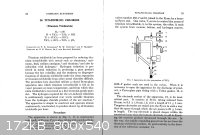 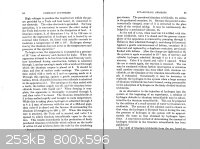 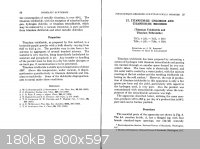 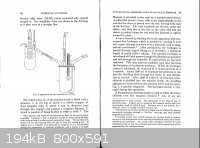 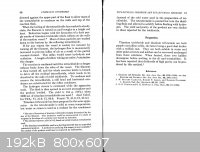
djh
----
People who liked this
book also liked :—
EB Partington
Chemical Plumbing and
Oxy-Acetylene Welding for
Plumbers and Heating
Engineers
The British Oxygen Comany Limited
London 1945
|
|
|
Lion850
National Hazard
   
Posts: 514
Registered: 7-10-2019
Location: Australia
Member Is Offline
Mood: Great
|
|
Report on making titanium (iii) chloride - this old thread seems the most applicable.
- 10g titanium powder in a 140ml beaker
- Add 33% HCl in stages until a total of 76g was added, this should be a slight excess of acid.
- Stir with stir bar. Initially a very slow reaction. Heat while stirring, switch off heat when reaction sped up. The beaker got so hot that I had to
place it in cold water at one point to make sure it does not boil off acid.
- Proof that hydrogen was being released by holding a match in the beaker, nice pops from the bubbles 
- The reaction seemed near completion in about 3 hours, but left overnight. Dark solution, purple in thin layer when swirled up the sides of the
beaker. Solution appeared slightly oily (for lack of a better word).
- Next day filtered about 95% of the solution. Place filtrate in desiccator under high vacuum over NaOH.
- Test the remaining few ml of solution with H2O2 - vigorous reaction, heat generated, blood red solution.
- Left the crucible in the desiccator for 4 days, pulling up the vacuum a few times a day.
- Remove from desiccator after 4 days. Surprisingly dry mass, varying from bone dry where thinner to slightly damp where thicker. Dark purple color,
see photo. Broke up into smaller pieces, into storage bottle. 40g recovered. See photo.
- Unsure of the yield because I do not know which hydrate it is.
- Did test with the small leftovers in the crucible: 1). Hygroscopic - gets wet when left. 2) Dark purple solution in water, that again gives the
blood red solution after addition of a few drops of H2O2 (the red does not show well on the photo)
Any help with the following questions will be appreciated:
- What is the shelf life of TiCl3 in a clear glass jar?
- What is the red compound that forms when adding H2O2, and can it be isolated as a red solid?
- Any suggestions of further experiments using this TiCl3 - especially if it leads to colorful compounds?
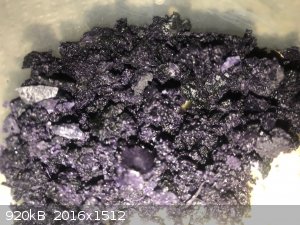 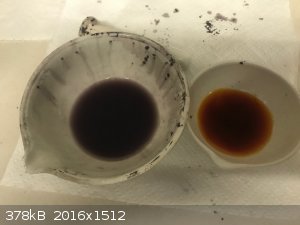 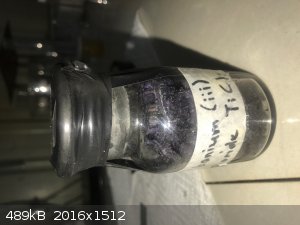
|
|
|
| Pages:
1
2
3
4 |